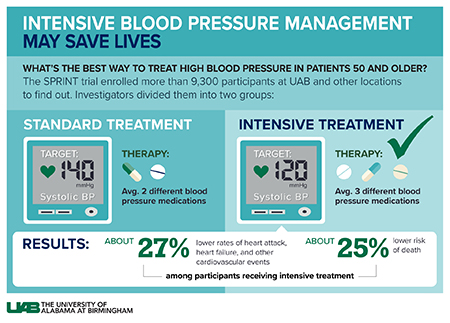 Final results of the UAB-led national study on high blood pressure confirm a target goal of less than 120 mm Hg reduces adverse eventsFollow-up data from the landmark SPRINT study of the effect of high blood pressure on cardiovascular disease has confirmed that aggressive blood pressure management — lowering systolic blood pressure to less than 120 mm Hg, dramatically reduces the risk of heart disease, stroke, and death from these diseases, as well as death from all causes, compared to lowering systolic blood pressure to less than 140 mm Hg. Systolic blood pressure is the upper number in the blood pressure measurement, 140/90, for example.
Final results of the UAB-led national study on high blood pressure confirm a target goal of less than 120 mm Hg reduces adverse eventsFollow-up data from the landmark SPRINT study of the effect of high blood pressure on cardiovascular disease has confirmed that aggressive blood pressure management — lowering systolic blood pressure to less than 120 mm Hg, dramatically reduces the risk of heart disease, stroke, and death from these diseases, as well as death from all causes, compared to lowering systolic blood pressure to less than 140 mm Hg. Systolic blood pressure is the upper number in the blood pressure measurement, 140/90, for example.
In findings published in the New England Journal of Medicine on May 19, 2021, investigators led by the University of Alabama at Birmingham presented new evidence of the effectiveness of reducing SBP to a target range of less than 120 mm Hg.
SPRINT was a randomized controlled clinical trial sponsored by the National Heart, Lung, and Blood Institute, part of the National Institutes of Health. Beginning in late 2009, it enrolled over 9,000 participants at least 50 years old who had SBP 130 to 180 and had increased cardiovascular disease risk. The NIH ceased randomly assigned treatments in 2015, when data was presented to the Data and Safety Monitoring Board that showed treatment to SBP of less than 120 decreased the rate of a composite cardiovascular disease outcome by 25 percent and the rate of all-cause death by 27 percent.
“We reported these findings in 2015, but continued to collect data into July 2016,” said Cora E. Lewis, M.D., professor and chair of the Department of Epidemiology in the UAB School of Public Health, and primary investigator of the study. “The current paper confirms and enhances the findings of 2015.”
SPRINT’s primary outcome was lower risk of having one of a composite of different types of cardiovascular disease outcomes related to blood pressure. These included heart attack, an acute coronary syndrome not resulting in a heart attack, stroke, acute heart failure, or death from cardiovascular disease.
The final results showed the risk of the primary outcome of the trial was decreased 27 percent and death from all causes was decreased by 25 percent in the group treated to less than 120 mm Hg compared to the group treated to less than 140 mm Hg.
“One criticism of the original SPRIN Cora Lewis, M.D.
Cora Lewis, M.D.
(Photo by: Steve Wood)T findings was that, of the components of the primary outcome, only heart failure and death due to CVD were significantly lower in the intensively treated group,” Lewis said. “The final results found that risk of heart attack, along with heart failure, and death from CVD, was significantly lower in the group treated to less than 120, and the risk of the primary outcome excluding heart failure was still significantly lower in the more intensively treated group.”
SPRINT also collected data on safety of the interventions. The investigators anticipated that serious adverse events, including hospitalizations overall, as well as hospitalizations and emergency room visits for specific conditions of interest, might be related to more intensive treatment of blood pressure with medicines. The final paper reports that overall serious adverse events did not differ, but there were more cases of some of the conditions of interest in the group treated to SBP of less than 120, including low blood pressure, fainting and acute injury to the kidneys, which usually resolved within one year. Falls leading to injury did not differ.
Lewis says the 2015 report looked at only the first case of one of the components of the primary outcome. Since heart disease can lead to multiple negative health effects, a new analysis of all cases of those components showed that the total number of primary outcomes, counting the first case and all recurrent cases, saw a 22 percent decrease in the group treated to a SBP of less than 120.
“Hypertension, or high blood pressure, is increasingly common and increases the risk of cardiovascular disease, the number one killer in the United States and most of the world,” Lewis said. “The take-home message from SPRINT is to talk to your doctor about your blood pressure to determine a good goal for you based on your overall cardiovascular disease risk. Then work with your doctor to achieve that goal.”
Lewis says that, prior to the SPRINT trial, research had shown that treating high blood pressure helped decrease risk of cardiovascular disease, but the optimum SBP goal was unknown. In 2007, a group of experts in high blood pressure research suggested that determining the appropriate goal of systolic blood pressure to reduce the risk of heart disease was of the utmost importance in preventing complications from hypertension.

Graphic by: Jody Potter (Click image to enlarge)“We know a lot about how to prevent and treat hypertension and SPRINT continues to greatly expand this knowledge, including the benefits of treatment on the heart, kidney and brain,” said David Goff, M.D., Ph.D., director of the Division of Cardiovascular Sciences at NHLBI. “As we implement what we know, more research is still needed to develop more effective prevention strategies for hypertension, improve its monitoring and control, and reduce the large health disparities associated with this disorder. Research teams supported by the NIH are continuing to work on these challenges.”
Nearly half of adults age 20 years and older in the United States have high blood pressure, which is defined as SBP of 130 or more or diastolic blood pressure (the lower number) of 80 or more. World Hypertension Day was May 17, 2021, recognizing how important high blood pressure is to the health of the world’s population.
In addition to primary sponsorship by the NHLBI, SPRINT was co-sponsored by the NIH’s National Institute of Diabetes and Digestive and Kidney Diseases, the National Institute of Neurological Disorders and Stroke, and the National Institute on Aging.